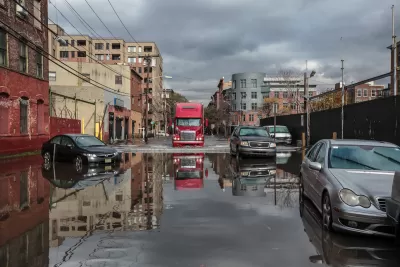Communities of color make up the majority of people harmed by pollution, as well as heat and flooding, says the study, which is New York City’s first comprehensive survey of environmental injustices.

A New York City report released last week by the mayor’s office found that nearly 50 percent of all New Yorkers live in areas disproportionately burdened by pollution, and the majority of those people live in communities of color. It marks the city’s first official comprehensive survey of environmental inequalities, reports Aliya Uteuova for the Guardian.
Researchers found that two-thirds of the people in historically red-lined areas, which are still to this day predominantly Black and Latino, live in areas the city calls environmental justice (EJ) areas.
These areas tend to have less tree cover and fewer parks (leading to hotter temperatures), greater vulnerability to stormwater flooding, and higher concentrations of highways, industrial power plants, and waste-water processing facilities nearby
The report’s findings are likely not a surprise to environmental justice advocates or the Black and Latino communities, who have long been sounding the alarm of poor health and economic outcomes for these neighborhoods. However, Peggy Shepard of We Act for Environmental Justice, who was involved in the report, told the Guardian that having these results officially documented by the city will ensure that environmental justice stays on New York City’s agenda. The next stage, she said, will be developing a citywide plan to address it.
FULL STORY: Pollution burdens nearly half of New York and communities of color most harmed – report

Planetizen Federal Action Tracker
A weekly monitor of how Trump’s orders and actions are impacting planners and planning in America.

Maui's Vacation Rental Debate Turns Ugly
Verbal attacks, misinformation campaigns and fistfights plague a high-stakes debate to convert thousands of vacation rentals into long-term housing.

San Francisco Suspends Traffic Calming Amidst Record Deaths
Citing “a challenging fiscal landscape,” the city will cease the program on the heels of 42 traffic deaths, including 24 pedestrians.

Trump Prompts Restructuring of Transportation Research Board in “Unprecedented Overreach”
The TRB has eliminated more than half of its committees including those focused on climate, equity, and cities.

Amtrak Rolls Out New Orleans to Alabama “Mardi Gras” Train
The new service will operate morning and evening departures between Mobile and New Orleans.

The Subversive Car-Free Guide to Trump's Great American Road Trip
Car-free ways to access Chicagoland’s best tourist attractions.
Urban Design for Planners 1: Software Tools
This six-course series explores essential urban design concepts using open source software and equips planners with the tools they need to participate fully in the urban design process.
Planning for Universal Design
Learn the tools for implementing Universal Design in planning regulations.
Heyer Gruel & Associates PA
JM Goldson LLC
Custer County Colorado
City of Camden Redevelopment Agency
City of Astoria
Transportation Research & Education Center (TREC) at Portland State University
Jefferson Parish Government
Camden Redevelopment Agency
City of Claremont




























